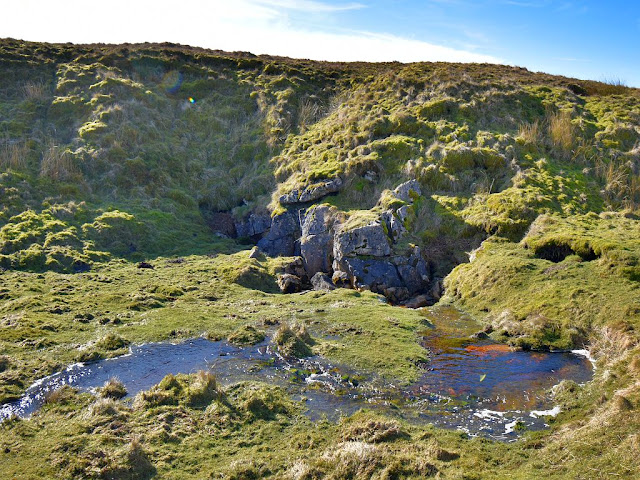
|
|
February 2022 |
Previous visits to Trollers Gill
noted the curious sight of a flowing stream disappearing underground half way
down the ravine, only to re-emerge in the empty stream bed to the south of the
gorge.

|
| Same view June 2021 |
For much of year the stream bed in the gorge forms a rocky path used by walkers trekking up the ravine (see pic below), but after winter rains the underground section of the watercourse cannot flow all the water, and so the stream runs in a torrent down the full length of the gorge.
The origins of this extra water can be traced to a spot about a mile to the north of Trollers Gill where an underground stream emerges from the Stump Cross Caverns cave system - but only after prolonged or heavy rains. The water rises up from several crevices and openings in the rocks alongside the normally dry stream bed, and then starts to flow down towards Trollers Gill.
This intermittent stream is called the Dry Gill, which at certain times of the year carries the waters flooding out from the extensive cave system underlying this area. Above ground, and further to the east, a dry stream valley curves around the north-east side of High Crags Hill, suggesting that the water may have also flowed along this route in the past. Following this dry valley eventually leads to a sink hole where a fast flowing stream plunges down into the same underground cave system. This stream is also called the Dry Gill (or Mongo Gill), and so people in the past must have realised that the two sections are linked by an subterranean passage. This upper section of the Dry Gill stream flows out of a large boggy morass on the south side of High Crag Hill. This is also the source of the river Washburn, with the river heading south and the Dry Gill running north. So much water flows out of this area that it suggests there are many buried springs within the morass, and the water is actually emerging from within the hill.

|
| The Dry Gill stream in summer and winter |
The Mongo Gill name is also of interest as it might suggest some
connection with the 6th century Celtic Saint Kentigern, who was also known as
Saint Mungo (there is a Saint Mungo's holy well at Copgrove, 16 miles to
further east). While this can only be speculation, the site of the Craven
Cross, just to the north of the Mungo Gill, is thought to have marked the
eastern border of the ancient British kingdom of Craven. Craven was part of a
chain of minor Celtic kingdoms stretching from Scotland down into Wales, and
it is recorded that saint Kentigern travelled to Wales when he was forced to
leave Scotland.
The ' Celtic' language spoken in Craven would have been Brythonic Welsh, and this probably accounts for some of the Welsh-like placenames that still exist in the region today, such as Peny-ghent. This may also provide a more realistic explanation for the Mungo/Mongo name which could be related to an old Welsh word for water. The name of the river Monnow in Wales apparently comes from Myn-gwy (mun-gu) meaning 'swift water'. The Welsh word 'mwn' (mun) can also relate to things rising or subterranean, and 'gwy' (gui) is an old welsh word for a flow of water or a flood. This would seem to describe the situation at Mongo Gill quite well, i.e. the swift or subterranean stream.

|
|
The upper Dry Gill stream sinks below ground |
In other parts of Britain these kind of intermittent streams were called 'Woe Waters', because when they started to flow it was believed to be an omen of misfortune. Whether this was the case for the Dry Gill stream is not recorded, but its annual rising from the 'underworld', and then flowing down the Trollers Gill gorge can have only added to the reputation of this being a place of supernatural danger.

Thoughts of the Gypsey Race in East Yorks, another winterbourne stream that is not only a Woe Water but also has a number of Neolithic sites along its course including Duggleby, Wold Newton & Rudston.
ReplyDeleteThanks for the comment G - The Gypsey Race did cross my mind, but i did not want to speculate too much when no folklore survives for the Dry Gill stream. When the waters start to flow it must be quite a strange sight, especially if you were walking up the gully.
ReplyDelete